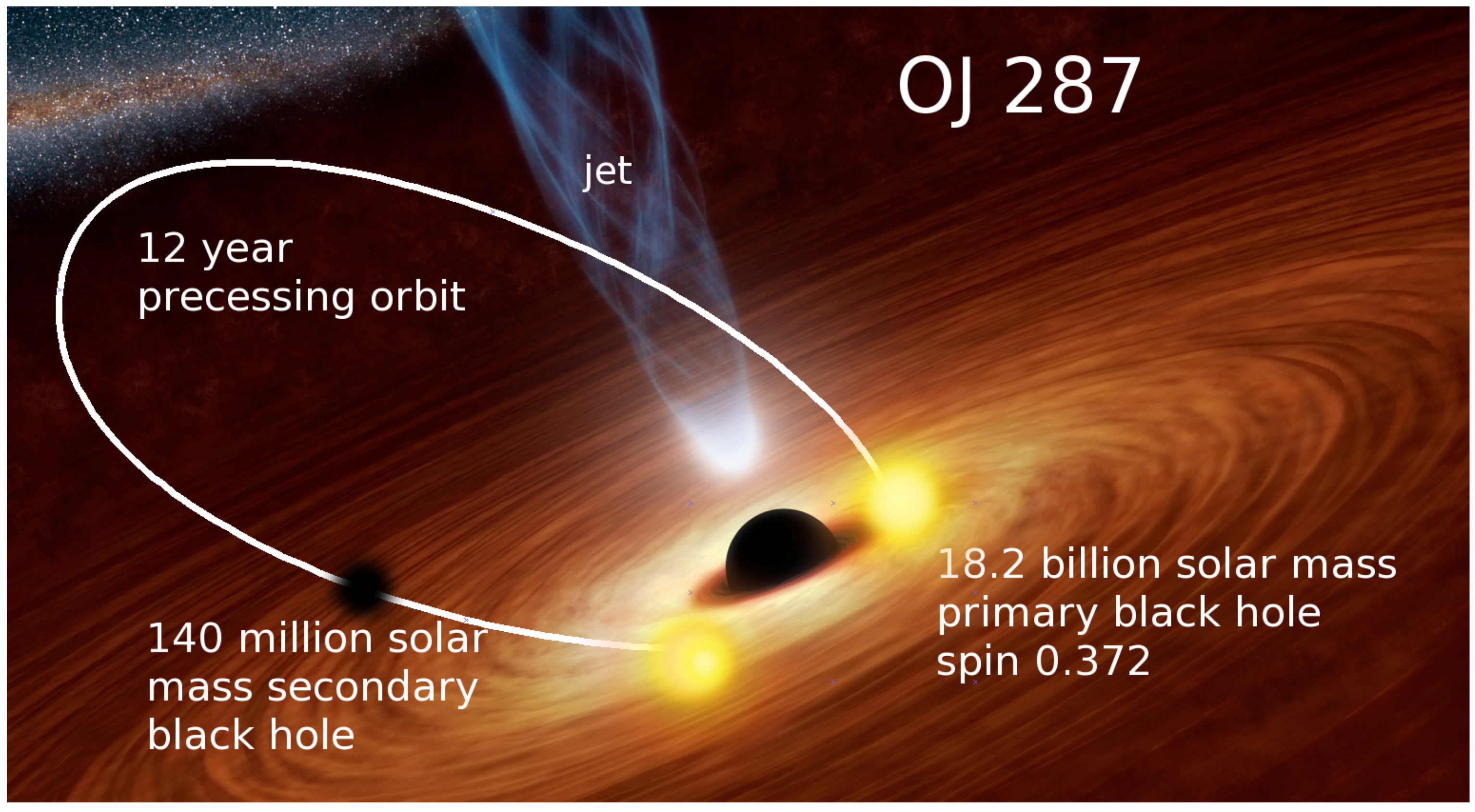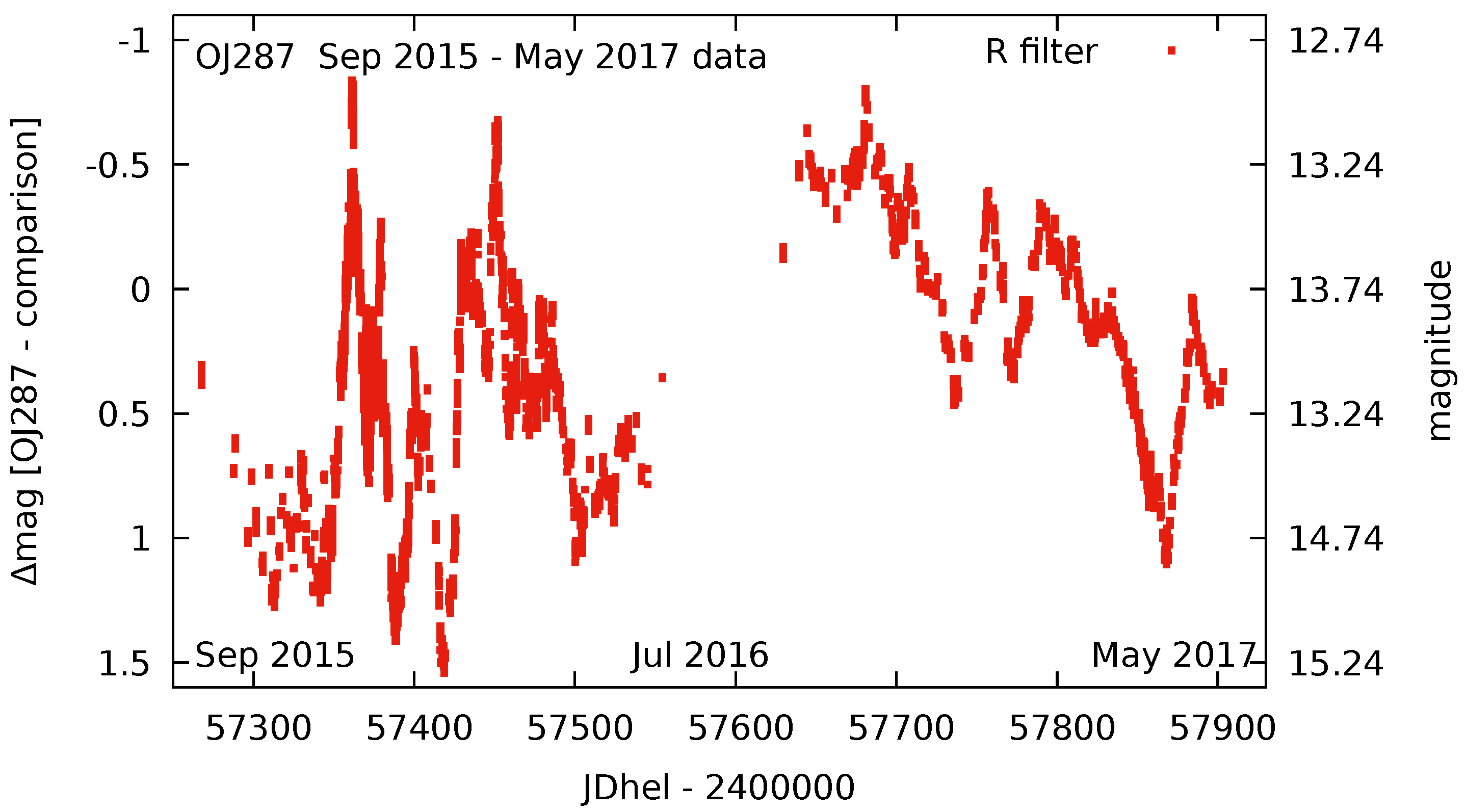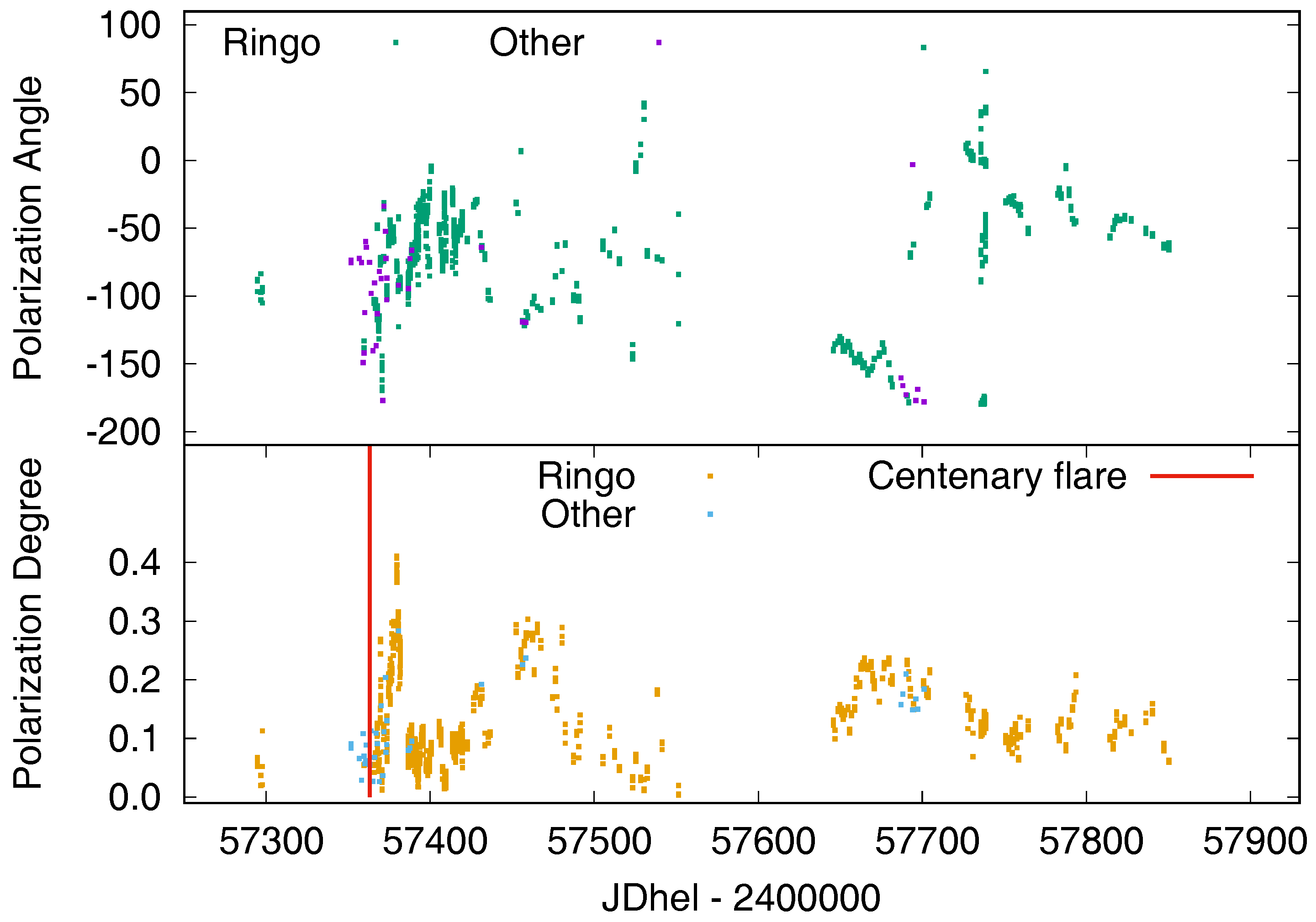Polarization and Spectral Energy Distribution in OJ 287 during the 2016/17 Outbursts
Abstract
:1. Introduction
2. Observations
2.1. Photometry
2.2. Polarimetry
3. Propagation of Accretion Disk Perturbations
4. Conclusions
Acknowledgments
Author Contributions
Conflicts of Interest
Abbreviations
| BH | black hole |
| SMBH | super massive black hole |
| JDhel | Heliocentric Julian Day |
| PA | polarization angle |
| PD | polarization degree |
References
- Sillanpää, A.; Haarala, S.; Valtonen, M.J.; Sundelius, B.; Byrd, G.G. OJ 287—Binary pair of supermassive black holes. Astrophys. J. 1988, 325, 628–634. [Google Scholar] [CrossRef]
- Hudec, R.; Bašta, M.; Pihajoki, P.; Valtonen, M. The historical 1900 and 1913 outbursts of the binary blazar candidate OJ 287. Astron. Astrophys. 2013, 559, A20. [Google Scholar] [CrossRef]
- Lehto, H.J.; Valtonen, M.J. OJ 287 Outburst Structure and a Binary Black Hole Model. Astrophys. J. 1996, 460, 207–213. [Google Scholar] [CrossRef]
- Valtonen, M. New Orbit Solutions for the Precessing Binary Black Hole Model of OJ 287. Astrophys. J. 2007, 659, 1074–1081. [Google Scholar] [CrossRef]
- Valtonen, M.J.; Mikkola, S.; Merritt, D.; Gopakumar, A.; Lehto, H.J.; Hyvönen, T.; Rampadarath, H.; Saunders, R.; Basta, M.; Hudec, R. Measuring the Spin of the Primary Black Hole in OJ 287. Astrophys. J. 2010, 709, 725–732. [Google Scholar] [CrossRef]
- Dey, L.; Valtonen, M.J.; Zola, S.; Ciprini, S.; Gopakumar, A.; Matsumoto, K.; Sadakane, K.; Kidger, M.; Gazeas, K.; Nilsson, K.; et al. GR Centenary flare in OJ287: Improved orbital parameters. In preparation.
- Pihajoki, P. Black hole accretion disc impacts. Mon. Not. R. Astron. Soc. 2016, 457, 1145–1161. [Google Scholar] [CrossRef]
- Sundelius, B.; Wahde, M.; Lehto, H.J.; Valtonen, M.J. A Numerical Simulation of the Brightness Variations of OJ 287. Astrophys. J. 1997, 484, 180–185. [Google Scholar] [CrossRef]
- Pihajoki, P.; Valtonen, M.; Zola, S.; Liakos, A.; Drozdz, M.; Winiarski, M.; Ogloza, W.; Koziel-Wierzbowska, D.; Provencal, J.; Nilsson, K.; et al. Precursor Flares in OJ 287. Astrophys. J. 2013, 764, 5–14. [Google Scholar] [CrossRef]
- Valtonen, M.J.; Zola, S.; Ciprini, S.; Gopakumar, A.; Matsumoto, K.; Sadakane, K.; Kidger, M.; Gazeas, K.; Nilsson, K.; Berdyugin, A.; et al. Primary Black Hole Spin in OJ 287 as Determined by the General Relativity Centenary Flare. Astrophys. J. 2016, 819, L37–L43. [Google Scholar] [CrossRef]
- Hroch, F. Computer Programs for CCD Photometry. In Proceedings of the 29th Conference on Variable Star Research, Brno, Czech Republic, 7–9 November 1997; p. 30. [Google Scholar]
- Steele, I.A.; Smith, R.J.; Rees, P.C.; Baker, I.P.; Bates, S.D.; Bode, M.F.; Bowman, M.K.; Carter, D.; Etherton, J.; Ford, M.J.; et al. The Liverpool Telescope: Performance and first results. Proc. SPIE 2004, 5489, 679–692. [Google Scholar]
- Arnold, D.S.; Steele, I.A.; Bates, S.D.; Mottram, C.J.; Smith, R.J. RINGO3: A multi-colour fast response polarimeter. Proc. of SPIE 2012. [Google Scholar] [CrossRef]
- Clarke, D.; Neumayer, D. Experiments with a novel CCD stellar polarimeter. Astron. Astrophys. 2002, 383, 360–366. [Google Scholar] [CrossRef]
- Jermak, H.; Steele, I.A.; Lindfors, E.; Hovatta, T.; Nilsson, K.; Lamb, G.P.; Mundell, C.; de Almeida, U.B.; Berdyugin, A.; Kadenius, V.; et al. The RINGO2 and DIPOL optical polarization catalogue of blazars. Mon. Not. R. Astron. Soc. 2016, 462, 4267–4299. [Google Scholar] [CrossRef]
- Kosenkov, I.A.; Berdyugin, A.V.; Piirola, V.; Tsygankov, S.S.; Pallé, E.; Miles-Páez, P.A.; Poutanen, J. High-precision optical polarimetry of the accreting black hole V404 Cyg during the 2015 June outburst. Mon. Not. R. Astron. Soc. 2017, 468, 4362–4373. [Google Scholar] [CrossRef]
- Sillanpää, A.; Takalo, L.O.; Pursimo, T.; Lehto, H.J.; Nilsson, K.; Teerikorpi, P.; Heinaemaeki, P.; Kidger, M.; de Diego, J.A.; Gonzalez-Perez, J.N.; et al. Confirmation of the 12-year optical outburst cycle in blazar OJ 287. Astron. Astrophys. 1996, 305, L17–L20. [Google Scholar]
- Sillanpää, A.; Takalo, L.O.; Pursimo, T.; Lehto, H.J.; Nilsson, K.; Teerikorpi, P.; Heinaemaeki, P.; Kidger, M.; de Diego, J.A.; Gonzalez-Perez, J.N.; et al. Double-peak structure in the cyclic optical outbursts of blazar OJ 287. Astron. Astrophys. 1996, 315, L13–L16. [Google Scholar]
- Valtonen, M.; Nilsson, K.; Villforth, C.; Lehto, H.J.; Takalo, L.O.; Lindfors, E.; Sillanpää, A.; Hentunen, V.; Mikkola, S.; Zola, S.; et al. Tidally Induced Outbursts in OJ 287 during 2005–2008. Astrophys. J. 2009, 698, 781–785. [Google Scholar] [CrossRef]
- Valtonen, M.; Ciprini, S.; Lehto, H.J. On the masses of OJ 287 black holes. Mon. Not. R. Astron. Soc. 2012, 427, 77–83. [Google Scholar] [CrossRef]
- Valtonen, M.; Lehto, H.J.; Nilsson, K.; Heidt, J.; Takalo, L.O.; Sillanpää, A.; Villforth, C.; Kidger, M.; Poyner, G.; Pursimo, T.; et al. Massive binary black-hole system in OJ 287 and a test of general relativity. Nature 2008, 452, 851–853. [Google Scholar] [CrossRef] [PubMed]
- Valtonen, M.; Ciprini, S. OJ 287 binary black hole system. Mem. S.A.It. 2012, 75, 282–287. [Google Scholar]
- Smith, P.S.; Balonek, T.J.; Heckert, P.A.; Elston, R.; Schmidt, G.D. UBVRI field comparison stars for selected active quasars and BL Lacertae objects. Astron. J. 1985, 90, 1184–1187. [Google Scholar] [CrossRef]
- Seta, H. Suzaku and Multi-Wavelength Observations of OJ 287 during the Periodic Optical Outburst in 2007. Publ. Astron. Soc. Jpn. 2009, 61, 1011–1022. [Google Scholar] [CrossRef]
- Valtonen, M.; Lehto, H.J.; Sillanpää, A.; Nilsson, K.; Mikkola, S.; Hudec, R.; Basta, M.; Teräsranta, H.; Haque, S.; Rampadarath, H. Predicting the Next Outbursts of OJ 287 in 2006–2010. Astrophys. J. 2006, 646, 36–48. [Google Scholar] [CrossRef]




© 2017 by the authors. Licensee MDPI, Basel, Switzerland. This article is an open access article distributed under the terms and conditions of the Creative Commons Attribution (CC BY) license (http://creativecommons.org/licenses/by/4.0/).
Share and Cite
Valtonen, M.; Zola, S.; Jermak, H.; Ciprini, S.; Hudec, R.; Dey, L.; Gopakumar, A.; Reichart, D.L.; Caton, D.B.; Gazeas, K.; et al. Polarization and Spectral Energy Distribution in OJ 287 during the 2016/17 Outbursts. Galaxies 2017, 5, 83. https://doi.org/10.3390/galaxies5040083
Valtonen M, Zola S, Jermak H, Ciprini S, Hudec R, Dey L, Gopakumar A, Reichart DL, Caton DB, Gazeas K, et al. Polarization and Spectral Energy Distribution in OJ 287 during the 2016/17 Outbursts. Galaxies. 2017; 5(4):83. https://doi.org/10.3390/galaxies5040083
Chicago/Turabian StyleValtonen, Mauri, Stanislaw Zola, Helen Jermak, Stefano Ciprini, Rene Hudec, Lankeswar Dey, Achamveedu Gopakumar, Daniel L. Reichart, Daniel B. Caton, Kosmas Gazeas, and et al. 2017. "Polarization and Spectral Energy Distribution in OJ 287 during the 2016/17 Outbursts" Galaxies 5, no. 4: 83. https://doi.org/10.3390/galaxies5040083




